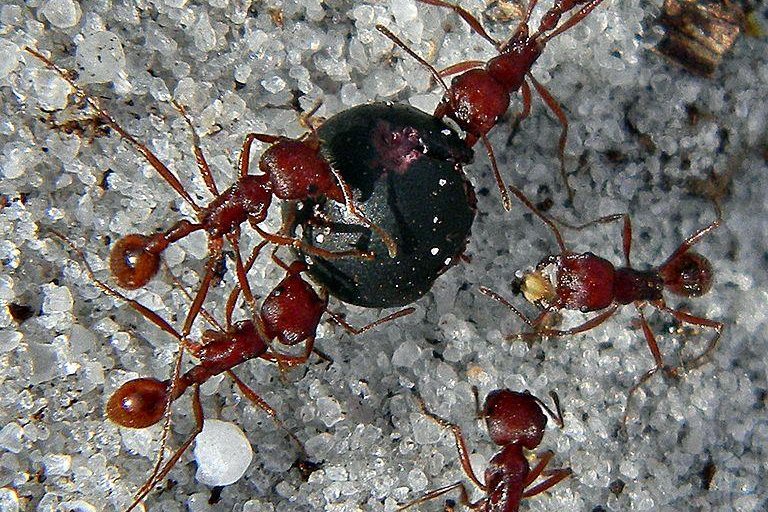Foraging ants find a blueberry. New research suggests ants use pheromones to differentiate among each other and between themselves and foreign colony members. Photo by Flickr/Bob Peterson
RIVERSIDE, Calif., Aug. 13 (UPI) -- Ant societies are some of the most compartmentalized in the insect world -- in the animal kingdom, for that matter.
But how do ants tell whether another ant is from the same colony, let alone determine a member's role in the society? How do they differentiate each other?
Researchers at the University of California, Riverside say ants do so by sensing a variety of chemicals on each other's cuticles, or outer shells. The mix of hydrocarbon chemicals present tell others who they are and where they belong.
To sense these chemicals, or pheromones, ants have developed one of the most complex senses of smell among insects. The ant genome, new analysis shows, possesses a remarkably large number of olfactory receptor genes.
Scientists used a powerful electrophysiology method to test whether ants could sense trace levels of various hydrocarbons -- previously identified as potentially significant in ant communication. The measurements showed ants' antenna neurons were excited by an array of pheromones, proving the insects can sense different hydrocarbons produced both by their nest mates and non-nest mates.
"To our surprise we found that these very low volatility compounds are not only detected sensitively by the ants' specialized antennal sensors, but almost all of the hydrocarbon components are detected," Anandasankar Ray, a neuroscientist and an associate professor of entomology at Riverside, said in a press release. "This broad-spectrum ability to detect hydrocarbons by the ant antenna is unusual and likely a special property of social insects. Using this high-definition ability to smell 'ant body odor' the ants can recognize the various castes in the colony as well as intruders."
The findings, published in the journal Cell Reports, contradict old ant societal models that suggested the insects could sense only whether another ant was part of the colony.
"The evidence suggests that this large number of receptors is probably needed to smell out the complex bouquet of hydrocarbons each individual emits," Ray said. "We are closing in to finding the functional roles of these receptors, and, in particular, finding the olfactory receptors that detect pheromones from the queen who regulates much of the order in the colony."
Scientists say the old model was too constraining. Such limits on smell wouldn't allow for the communication and cooperation necessary to run a regimented, highly complex insect society.
"This model started to seem unlikely after we found how broadly the worker antennal neurons can respond to hydrocarbons," Ray added. "When we tested this with our sensitive electrophysiology assay we found that ants can indeed detect both nest mate and non-nest mate cuticular extracts, as we had predicted."















